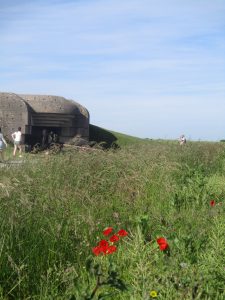Today marks Day 9 of our battlefield adventure, and in spite of our aching feet, overfilled brains, and some sweltering heat, we’ve (mostly) remained happy and eager to continue our great learning experience by visiting more sites and sharing more history. As seen in the past couple blog posts, we’ve now fully transitioned to a focus on the Second World War, and right now we’re studying the invasion of Normandy in the summer of 1944. While we’re coming from a Canadian-oriented point of view, we are also trying to approach the historical events from a wider range of perspectives. We began today at the Longues-sur-mer Battery, in order to better visualize the German defences on the French coast at the time. Then, we visited the Arromanches museum to garner a wider understanding of the whole Allied operation. Following those stops, though, we visited some important Canadian sites of commemoration: Juno Beach and the Juno Beach Centre. The beach today is largely a place for tourists, for lounging in the sun, for kids to build sand-castles and play in the water; looking at the shoreline, and seeing those contemporary activities, it’s hard to imagine that same beach 75 years ago, when thousands of soldiers lost their lives. To commemorate that, though, are plaques, monuments, signs, and flags; moreover, there are bunkers and, of course, the Juno Beach Centre. All these items raise questions on how commemoration works, especially concerning popular historical memory. Why were these places chosen, and who decided? Why this monument, or this preserved site? Why these interpretations, instead of others? How much goes unsaid?
How history is shaped today, through monuments, historic sites and interpretive centres, impacts how history will be taught years from now. That responsibility, then, to be as accurate, as effective, and as respectful as possible, is an issue that all historians have to grapple with. As we wandered those spaces today, I know that many of us were considering these issues. Hopefully, we will carry those ideas with us into our futures. 
Cora Jackson
